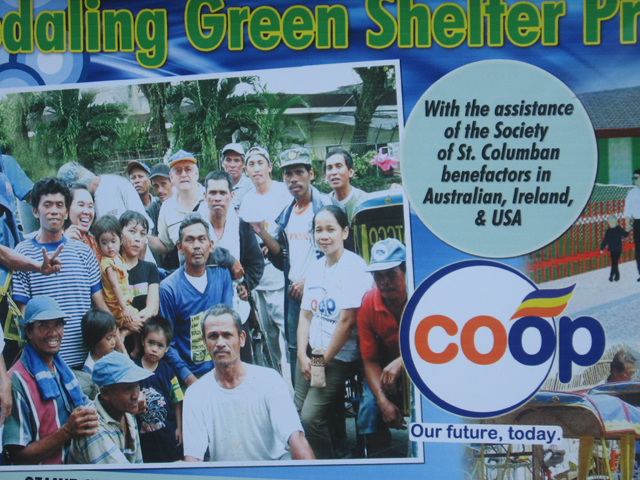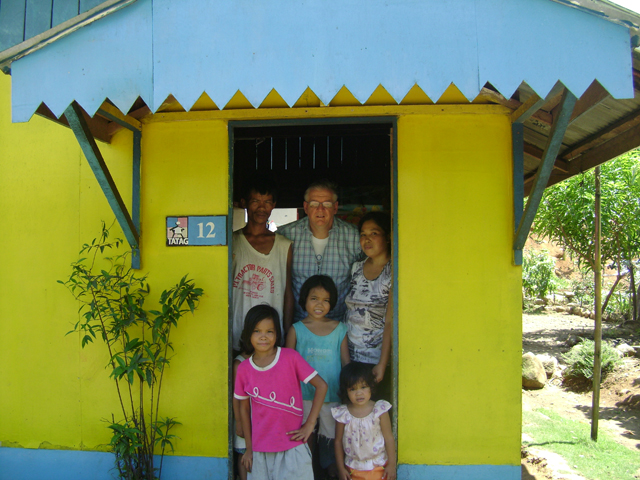Misyon Online - September-October 2012
COMMENTS
See more Misyon Videos
Living in an Indo-Fijian Village
by Kurt Zion V. Pala
Fiji is a multicultural country. The Indians who arrived in the country were brought by the British about 100 years ago to work in the sugarcane plantations across the country. Now they have settled in the country and are considered Fijians. They still have their distinct Indian culture and traditions but have well established themselves in Fiji. I have from the beginning been assigned to live and work with them and so learned their language and lived in the village with one Indo-Fijian family for a period of five months.
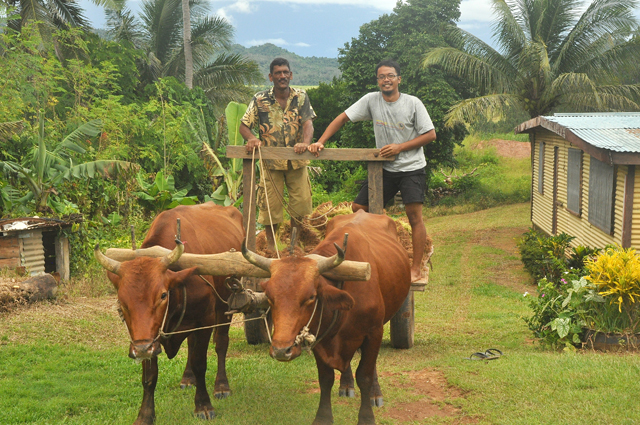
Riding on the tamtam with Nana (‘Lolo’) Barabhabuon
It was already about five in the afternoon but I had told my host father that I would be home by around one so I told them I have to leave because it was getting dark. I often get scolded for coming home late. But I always have my good reasons. ‘Khub ghar ghar ghume?’ my host mother exclaimed. She told me that I’d been roaming around the village the whole day. So I just put on my best smile and greeted them. I lived with an Indo-Fijian family, Uncle Bhola and Auntie Mary, for almost five months.
A Church Grows in the Vast SteppesBy Bishop Wenceslao S. Padilla CICM
Arriving when the Republic of Mongolia had just been liberated from the grip of Soviet Russia, the country was on its first faltering steps to stand on its own. The newly constituted government was trying to address the various problems and needs of the country and the people. It was somewhat chaotic in the public places as a hunger strike was being staged in front of the Parliament/Presidential building asking for the stepping down of the then Prime Minister. The one leading the demonstration was a fearless and committed advocate of democracy, now President of Mongolia, Mr Tsakhiagiin Elbegdorj. |
'My Life Changed for the Better'By Anne Gubuan
Jerry was driving his passenger along the busy streets of Ozamiz City. His son was also seated beside the foreigner. The man was so amused at his son, talking to him in straight English. Jerry didn’t mind the heat of the sun and the strain in his legs from pedaling. He was so full of pride over the fact that his son was talking to the foreigner, amusing him with his intelligence. It is in his six children that Jerry’s hope comes alive. |
 |
 |
|
|
|
The Palm Branch and the Lily
By Hannah Carter
A young Filipino martyred in Guam in 1672 when he was maybe 17, Blessed Pedro Calungsod, who is shown in portraits holding the palm of martyrs, and a young woman of Mohawk-Algonquin parentage born in 1656 in what is now New York State, Blessed Kateri Tekakwitha, known as the Lily of the Mohawks, who died in 1680 in what was then New France, now part of Canada, will be canonized together by Pope Benedict XVI on 21 October. The author, an American with close family ties to the Philippines, sees the connections between their lives and with that of her teenage son.
We have great cause for joy in the canonization of the teenage martyr Blessed Pedro Calungsod on 21 October. His devotion, courage and zeal to share his faith as a catechist are a shining and attractive example for all of us. St Pedro’s youth makes his story all the more poignant. Our teens are blessed to have such a model as they strive to live the Catholic Faith in a secular world, often hostile to the message of the gospel. I am the mother of an older adolescent and I have witnessed my son’s struggles, surrounded by these negative influences. It is hard to be a young person in today’s world, although the grace of Our Lord always suffices.

Remembering Ate Bem
By Churchill G. Aguilar
This article first appeared in the Sun*Star, Cagayan de Oro City, on 17 July. It is slightly edited here. The author was in the Columban College Formation Program in his college days, when he studied at the University of San Carlos, Cebu City.
Editor’s note for non-Filipinos: ‘Ate’(AHteh) is a Tagalog term of affectionate respect for an older sister or for a woman to whom you relate as to an older sister.
In her illness, I saw strength: a paradox I witnessed in the life of my eldest sister, Ate Bem.
At age six, Ate Bem was diagnosed with rheumatic heart disease. Since then, the hospital had been her second home, yet it never took the smile off her face.
Ate Bem was very determined to live a normal life. Even with her absences from school, she always managed to be an honor student. She never made her illness an excuse to escape from her responsibilities as the big sister to her five siblings.
Pulong ng Editor
'My Life Changed for the Better'
By Anne Gubuan
Jerry was driving his passenger along the busy streets of Ozamiz City. His son was also seated beside the foreigner. The man was so amused at his son, talking to him in straight English. Jerry didn’t mind the heat of the sun and the strain in his legs from pedaling. He was so full of pride over the fact that his son was talking to the foreigner, amusing him with his intelligence. It is in his six children that Jerry’s hope comes alive.
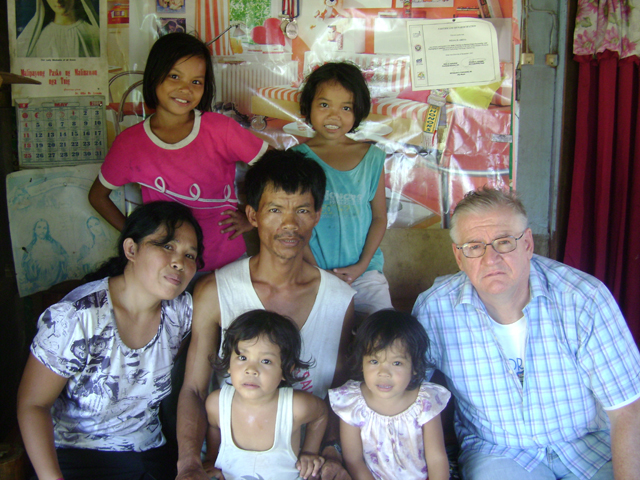
Fr Oli McCrossan with Jerry's family
Jerry didn’t even finish elementary school. Growing up in a violent home where his alcoholic father frequently beat him he ran away at an early age. That’s why, when he met Wilda and married her in 1996, he vowed to himself never to lift a finger to his wife and children. This was something that he struggled with, raising his family. Most of the time he was scared of his own temper. Whenever he would lay a hand on one of his children, he would feel very guilty.
Things started to change when he and Wilda became members of Couples for Christ in 2003. ‘Nagkaroon ako nang bagong buhay’, he mused when asked what kind of change he was referring to. ‘Mas maganda ang buhay sa CFC. Lahat nang ginagawa mo parang meron nang kabuluhan.’ He said that he started looking at difficulties as ‘pagsubok’. Something more hopeful, than hopeless and complaining. His faith has helped him change his ways for the better.
They’ve become Household Leaders (leaders in their cell group, where they gather their members every week for a prayer meeting and sharing of their faith life) of six couples. Jerry and Wilda, in spite of the challenges of leading six couples, have remained faithful to their commitment. There are times when instead of attending their prayer meeting, some members would rather focus on their livelihood so they would have food on their table. This Jerry knows too well having experienced the same thing while they were just starting in the CFC. There were times when he would be too embarrassed to attend CFC assemblies because he didn’t have any decent clothes to wear.
But all these things he considers trials for a Christian like him who wants to have another shot at life. He feels grateful to be one of the beneficiaries of the Pedaling to Live under the guidance of Fr Oliver McCrossan. They were among the few who were privileged enough to be qualified for the housing program. Fr Oli dreams of a sustainable community for the trisikad drivers and their families. Jerry, along with the rest in their small community, works hard for it. His ultimate dream is to see his children finish their education, something that he and his wife didn’t have the chance to accomplish.
In a place like Ozamiz there are many challenges and difficulties that people like Jerry have to face in order to at least keep discouragement at bay. ‘Opportunities for people like us are always scarce, not to mention the fact that we also fight among ourselves in order to survive’. But every day, he chooses to remain steadfast for his family. ‘Kung galit ka sa kapwa, hindi ka malayo sa malas.’ For him, it is a conscious decision that he has to make every day. ‘Kung gagawa ka ba nang masama, o kung gagawa ka nang mabuti.’ He wants to do well so that his children will reap the harvest. There is no other way for him but to keep trying to change for the better. This is to at least repay the kindness of the people God sends his way to make his dreams come true.
A Church Grows in the Vast Steppes
By Bishop Wenceslao S. Padilla CICM
Bishop Padilla is from Tubao, La Union. After working in Taiwan he was appointed to lead the first group of missionaries in modern times to Mongolia in 1992. He was ordained bishop in the then newly built Cathedral of Sts Peter and Paul in Ulaanbaatar, the Mongolian capital, on 29 August 2003. The Prefecture of Ulaanbaatar was established on 8 July 2002 and covers the whole of Mongolia, which has a population of around
2,800,000 and a land area more than five times that of the Philippines. Bishop Padilla is the first bishop ever in Mongolia and the first Filipino to be appointed bishop of a jurisdiction outside of the Philippines. The Papal Nuncio to Mongolia, Archbishop Osvaldo Padilla, who is based in Korea, is a priest of the Archdiocese of Cebu. The two are not related.
Brief History
On 10 July 1992 a Church was born in the steppes of Central Asia. This happened when three missionaries of the Congregation of the Immaculate Heart of Mary (CICM) set foot on Mongolian soil. It felt like it was an adventure for the three male religious to spearhead a mission where the Church had no physical structures or members to call her own. From the start, to establish a Church from scratch was a scary endeavor, full of challenges and excitement as well.
Arriving when the Republic of Mongolia had just been liberated from the grip of Soviet Russia, the country was on its first faltering steps to stand on its own. The newly constituted government was trying to address the various problems and needs of the country and the people. It was somewhat chaotic in the public places as a hunger strike was being staged in front of the Parliament/Presidential building asking for the stepping down of the then Prime Minister. The one leading the demonstration was a fearless and committed advocate of democracy, now President of Mongolia, Mr Tsakhiagiin Elbegdorj.
First Contacts
Staying in rented apartments, we slowly found our way into the hearts of the Mongols by trying to be one with them experiencing the hardships and difficulties of life at that time. There was a scarcity of food and lack of commodities. Mongolia was a 'hardship country' according to many foreigners whom we met during the first days of our integration. Not long afterwards nonetheless, after having acquired more knowledge of the people and their way of life, and after learning a bit of their language, we became more confident in making contacts with the locals.
 ‘Come and See’ was then our adopted watchword for people to feel welcome and comfortable in associating with and getting close to us. Questions such as ‘Who are these foreigners?’ . . . ‘What do they do?’ . . . and ‘What are they in Mongolia for?’ were gradually answered when we started inviting and gathering people for liturgical celebrations, organizing catechism classes and doing social action activities.
‘Come and See’ was then our adopted watchword for people to feel welcome and comfortable in associating with and getting close to us. Questions such as ‘Who are these foreigners?’ . . . ‘What do they do?’ . . . and ‘What are they in Mongolia for?’ were gradually answered when we started inviting and gathering people for liturgical celebrations, organizing catechism classes and doing social action activities.
The first years were periods of survival, adjustment and adaptation to the physical realities of the country and its people. For the trio, they were truly years of discernment, enculturation and primary evangelization . . . the first contacts of the institutional Church with people of other religious beliefs and convictions.
We didn't mind so much the challenging difficulties that befell us such as extremely harsh winters, the language barrier, the lack of commodities, the strong religious affiliations of the people to Buddhism, Shamanism, and Islam, the presence of other Christian denominations and sects, and the absence of Church structures and local Catholic believers. Personally, I took all of these as positive aspects of mission life. Such conditions offered to us a challenge and an opportunity. We maintained a strong conviction that the God who called and sent us to Mongolia had already been present in the ordinary lives of our Mongolian brothers and sisters even before we arrived. This thought propelled us to grow in appreciation and understanding of the concrete realities of the country and its people.
A quick look at the Church in Mongolia today
Looking back on these first 20 years of the Catholic Church’s presence in Mongolia, we are glad to repeat with the psalmist: Indeed He did great things for us; how happy we were (Ps 126:3).
From the three pioneer missionaries, we now have 81 strong, from 22 different nationalities, and from 13 groups/religious congregations -- CICM, ICM, SPC, MC, Fidei Donum Clergy, SDB, CJ, IMC, MDC, FMA, INBO, Lay Volunteers and JLMM. (See ‘box’ below). And from a zero Catholic population, around 835 Mongolian brothers and sisters have now joined the Catholic fold through Christian initiation. Many more are being introduced to the Catholic faith and are served through different outreach programs of the missionaries.
With the significant increase of Church personnel (missionaries and local collaborators) pastoral, social, developmental, educational, humanitarian and charitable works keep evolving and continue to flourish. These projects are all geared towards uplifting the plight of poor people. The mission now prides itself on having four parishes and six sub-stations with social outreach services: two street children centers, a home for elderly men, two Montessori kindergarten schools, two primary schools, a center for handicapped children, a technical school, three libraries with study halls and computer facilities, a lady’s dormitory for university students that is equipped with a study hall and computer/internet facilities, youth activity centers, two agricultural farms with community building programs, an outpatient clinic with laboratory, a Mostaert Research Center, campus ministry, three soup kitchens, language programs, Caritas-Mongolia (with programs such as digging and restoring deep wells, home industry, sustainable agriculture, food security, preventing human trafficking, and doing relief services in the countryside), a retreat center, social centers with poverty alleviation programs, and scholarships for poor but deserving students from the cities and countryside.
This year, to boost the 20th anniversary of the Catholic Church Mission, one of the parish sub-stations, Mary Mother of Mercy, will be upgraded to parish status. The Prefecture’s Elementary School, the construction of which started construction two years ago, will also be inaugurated.
We too are glad that two young Mongolian men are now in one of South Korea’s major seminaries and studying at the Catholic University of Daejeon, pursuing their vocation to the priesthood.
With all these, we are now able to look to the future with much hope and confidence. With patience and determination we are resolved to reach out to more people not only to those who have already joined us in the faith but also to those who are served in our works, though not yet baptized.
A frustration, however, is creeping into the adolescent Church. Around 23 percent of the baptized are no longer frequenting Church liturgies. Some have already given up on the Church. Another 15 percent are abroad in pursuit of greener pastures. We hope that they are still practicing some sort of Christian life wherever they are.
Looking into the future with its challenges
Twenty years have passed. It’s now hard to trace back where we started. With the rapid metamorphosis/transformation of the society brought about by democracy and the market economy, Mongolia heads into a future unimaginable to previous generations. It is now in the limelight and caters to the greed of foreign investors due to its wealth in natural resources. Mining has boomed in recent years and is drawing a migration movement from the cities to the countryside. There is also an influx of foreign experts/workers building the infrastructures of the mining industry and doing the initial mining operations.
With the development brought about by this phenomenon, the standard of living of the people is reaching higher levels. The cost of living and the cost of commodities are reaching new levels. To cope with this situation, the people are allocated subsidies from the government that already takes considerable amounts from the investments tendered by the mining companies. As it were, the ‘not yet realized gains’ from the mining activities are already being used by the political authorities to share with the people. As a consequence, most of the government’s dividends from the profits of mining will most likely go back to the investors once the mining operations are fully developed and profitable.
The Catholic Church is very much affected by the trend of the present times. The challenges we have to encounter as a Church are tremendous. What’s happening might be beneficial to the people but to the detriment of the Catholic Church that seeks its support and sustenance from abroad. There is no local income as the Church is registered as a non-profit-making organization. This year’s increase of salaries by 53 percent also adds heavily to the Church’s financial burdens. It’s most likely that the missionaries will have to tighten their belts, let go of a good number of personnel or close down some of their projects.
Along with the above mentioned difficulties the Church faces is the much smaller foreign grants and donations to sustain its projects. The funding agencies, which are affected by the ongoing economic recession, can no longer give as much as in former years. Benefactors who hear or see the advertisements/propaganda about Mongolia’s rise to wealth are also giving less. With this new situation the Church has to hurdle greater obstacles to survive.
Another condition that the Church has to put up with is the revival of Shamanism, the culture-based religion of the people, propagating the worship of nature, and Tengerism (worship of the Blue Skies). People are again going back their ancient cultural customs and traditional beliefs because of a resurgence in these.
Finally, due to the need of numbers to run the mining operations, I surmise that with this new situation, there ought to be a shift in Church/mission strategies to help address the pressing needs of the people ushered in by the expected reverse migration from urban to rural areas.
Role of the Church: What can the Church offer to Mongolia today?
To be relevant, the Church has to look harder into the future adopting itself to the fast changing society propelled by democracy, the market economy, materialism and consumerism. To serve a people who have gone from being a nomadic pasturing community to being settlers in the cities and mining sites, with an augmented sedentary form of existence, the Church has to adopt new avenues of apostolate/ministries to carry out her evangelizing mission, the spread of the Gospel. In order to thrive the Church will need to concentrate on helping the people in preserving or acquiring the values of civilized living. This can be achieved, I believe, by inculcating human and Christian values and the discipline that goes with these.
We are crossing a threshold from the past twenty years where the Church has concentrated her efforts on social-developmental-humanitarian works. These still remain as involvements since many of the people, especially those in the countryside and the newly arrived migrants in the cities, are still struggling with their social and economic life due to the lack of social ethics and the bloated price of commodities. However, the pastoral and educational roles of Church have come of age.
I see that education with its varied ramifications has to be embraced. I believe that in whatever direction Mongolia and its people are going, a change in mentality from that of a nomadic/rural to a sedentary/urban way of life has to take place. This can only happen with the right attitudes and ways of behavior to be ushered in by proper learning. The Church propels herself in this respect by making a shift in her strategies and thinking of new paradigms in her evangelizing mission.
Meanwhile, we have to readily maintain our reputation as a welcoming Church and the defender of the poor, offering moral strength to the needy. In order to be credible and trustworthy agents of evangelization, the life-witness of her constituents must be consistent in their preaching and Christian way of life . . . witnessing to the Gospel and its values in word and deed.
By way of conclusion
I believe that this Church thrives with God's Spirit leading her. She survived the earlier and more difficult years of her existence through the dedication and commitment of the missionaries and their lay collaborators, and I know that she continues to grow with the ongoing endeavors of her pastoral agents and cooperators coupled with the generosity of philanthropic individuals and groups of other particular Churches all over the world. To our benefactors, we are indebted indeed! A grateful note of thanks to our supporters! Thanks and God Bless!
Moreover, a strong spirit of collaboration and organization, such as integrating our different congregational charisms in a common effort and with a common vision, is very much needed. The spirit of unity and communion among the missionaries is a must, as it is the best testimony we can offer/transmit to our Mongolian people. Also, the personal life of each of the pastoral agents is a powerful way of testifying to the Gospel. The words of Pope Paul VI are all the more true in our situation: ‘Men and women today listen more gladly to the witnesses than to the masters, and if they listen to masters, it is because they are witnesses’ (Evangelii Nuntiandi, § 41).
Equipped with her Pastoral Plan and Mission Vision, the Mongolian Mission moves onwards into the future, fully mindful of the ‘WE’ of the Church, the ‘we’ of the apostolic faith. Each one has a different task in the field of the Lord, but we are all God's fellow workers. This is valid for us today and in the future, for every Christian. We are all humble ministers of Jesus. We serve the Gospel in the measure that we can, according to our gifts, and we ask God to make His Good News and His Church Community develop today and in the time to come through US.
And so, beyond fulfilling our functions effectively, the real challenge of being true missionaries, called upon to help transform the lives of those we come in contact with, is our resolve to allow ourselves to be converted by God’s transforming WORD.
The website of the Catholic Church in Mongolia is here.
+++
Misyon has published articles on the Church in Mongolia in a number of previous issues.
Missionary Groups in Mongolia
CICM: Congregation of the Immaculate Heart of Mary.
ICM: Missionary Sisters of the Immaculate Heart of Mary.
SPC: Sisters of St Paul of Chartres.
MC: Missionaries of Charity.
Fidei Donum Clergy.
SDB: Salesians of Don Bosco.
CJ: Congregation of Jesus.
IMC: Consolata Missionaries.
MDC.
FMA: Daughters of Mary Help of Christians (Salesian Sisters of Don Bosco)
INBO: Congregation of Charity of the Blessed Sacrament.
Lay Volunteers.
JLMM: Japan Lay Missionary Movement.
Father Joeker

By Fr Joseph Panabang SVD
The marriage ceremony was set for 10:00 AM. By 12:30 PM a procession was in sight. ‘Here they are; prepare!’ I alerted the altar boys but the excitement died abruptly when, to our surprise, behind the choir we saw a coffin. It was a group of Methodists on their way to the cemetery to bury one of their members. Sympathy and laughter were quite hard to combine. Finally at 3:30 PM the bride and the groom came. And that was my first and last time to officiate at a wedding ceremony in Asesewa, Ghana. Not until did I know I could be that patient.
Brutus and Castro are our two German Shepherd dogs in Asesewa, though not purebred. One night I heard Brutus barking wildly, kicking its house and feeding trough with such noise that he was obviously misbehaving. The following morning, I asked Georgina, our cook, what had happened last night and giggling she answered, ‘I gave him only a little food’. Then I remembered that the dog food had run out a few days earlier and the next consignment was still to come.
After our Mass in Akumerso-West village in Asesewa Parish, Eastern Ghana, we went to pray for the newly born twins of a couple in the parish. Before praying I asked what their names were and was told, ‘Mary and Abraham’. ‘What a combination’, I kept musing to myself. ‘Why not Mary and Joseph?’
The Honorable Stephen Amanor was elected MP (Member of Parliament) to represent Asesewa District, Eastern Region of Ghana. At the end of a Mass in thanksgiving for his victory he was thanking the people when suddenly the cloth covering the pulpit surprisingly fell down. After his talk, I picked up the royal blue cloth and raising it high in full view of everyone asked, ‘Do you know the reason why this well-pinned cloth suddenly fell down?’ Breaking the deadly silence, I continued, 'It is because if this cloth could speak it would say, “I am not worthy to be in front of a humble man speaking”’. And the Hon. Stephen is known for his humility. Thunderous applause erupted from the congregation.
Living in an Indo-Fijian Village
By Kurt Zion V. Pala
Fiji is a multicultural country. The Indians who arrived in the country were brought by the British about 100 years ago to work in the sugarcane plantations across the country. Now they have settled in the country and are considered Fijians. They still have their distinct Indian culture and traditions but have well established themselves in Fiji. I have from the beginning been assigned to live and work with them and so learned their language and lived in the village with one Indo-Fijian family for a period of five months.

Riding on the tamtam with Nana (‘Lolo’) Barabhabu
It was already about five in the afternoon but I had told my host father that I would be home by around one so I told them I have to leave because it was getting dark. I often get scolded for coming home late. But I always have my good reasons. ‘Khub ghar ghar ghume?’ my host mother exclaimed. She told me that I’d been roaming around the village the whole day. So I just put on my best smile and greeted them. I lived with an Indo-Fijian family, Uncle Bhola and Auntie Mary, for almost five months.
Right after my Hindi class with Master Gyan, I would walk back home from the Mission House. I had to climb a hill and on the way passed by about 10 houses. On any given day people would call out for me to have some tea or yangona or on some special days even get free lunch of goat curry, rice and dhal. This is what I enjoyed most when I was living in Paharkhaala, up in Naleba in Labasa, not just the food but also the people.
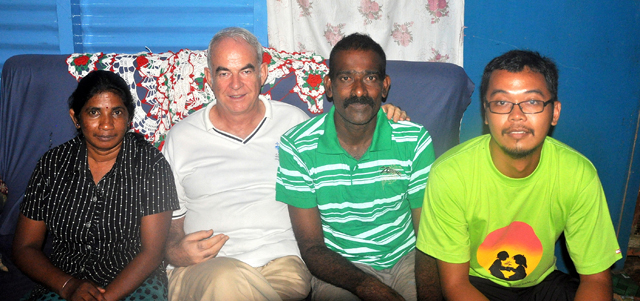
Together with Fr. Frank Hoare, Auntie Mary and Uncle Bhola
‘Aja, aji , salaam walaikum!’ I greeted the Muslim couple that I never miss seeing on my way home. Aji never fails to greet me when she sees me and says everytime, ‘Go my child and take care’. She’s fond of children. That includes me because none of her children are with them anymore.
From the top of the hill, I could see the girls waiting for me. I sometimes help them out with their homework. ‘Namaskaram brother!’ I heard them greeting. Auntie asked me to have lunch first. Sitting on the veranda I saw old man Barabhabu riding on something driven by two big bullocks. I knew what it was so I exclaimed, ‘Nana, aapke tonton? ‘Is this your tonton?’ Nana just laughed and told me that it is called tamtam, not tonton. After revising their homework I told them I had to go.
Just a few steps further on is Almilu attha’s place. I saw her sitting under the tree and so I called out, ‘Attha, kaise hai?’ Almilu attha is my host father’s older sister. Before I could say no, she had already set a cup of tea and pudding cake before me. I told her I would be celebrating my birthday with the children the following Sunday. I finished my tea and left.
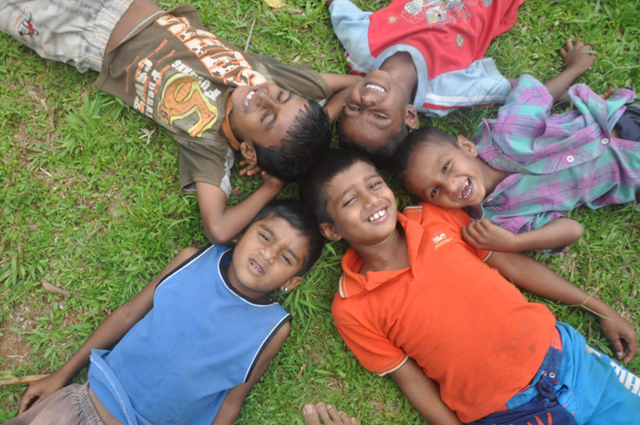
All smiles after some games and sweets, children of Paharkhaala
I decided to see the parents of the children and asked them if the children could come to my small birthday party. All the children came in their best dress. I was surprised to see Guddhi and Dennis wearing shirts at all, as they usually run around half-naked. The children enjoyed the games and sweets but I guess I enjoyed the day the most.
I try to visit all the families in the village not just the Catholics. Boss nana, a devout Hindu, invited me to his place. I learned that he owns two milking cows and so I asked him if I could come and learn to milk the cow. Early next day, I went back to his place and saw him tying the two hind legs of the cow. He showed me how to do it and I just started milking the cow. I went home happy with two bottles of fresh milk.
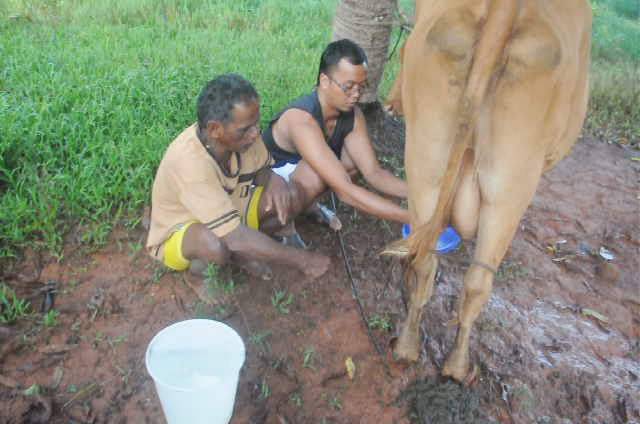
With Boss nana, milking the cow
If you ask me how I spend my day, I would say, ‘Ghar ghar ghume!’ and that is how I am learning more about the language, culture, and every aspect of life in an Indo-Fijian village. I have grown to love the people and from being a stranger have become ‘family’ because they started to call me beta (son), natin (grandson), bhaeni (nephew), and bara anna (big brother). And I will never forget one little girl who calls me Brother-Mama (Brother-Uncle) . Thank you Naleba! I hope I have brought you as much joy into your life as you have brought into mine.
May we become missionaries of joy to every person we meet – regardless of their faith or color.
Our Hideaway
Remembering Ate Bem
This article first appeared in the Sun*Star, Cagayan de Oro City, on 17 July. It is slightly edited here. The author was in the Columban College Formation Program in his college days, when he studied at the University of San Carlos, Cebu City.
Editor’s note for non-Filipinos: ‘Ate’(AHteh) is a Tagalog term of affectionate respect for an older sister or for a woman to whom you relate as to an older sister.
In her illness, I saw strength: a paradox I witnessed in the life of my eldest sister, Ate Bem.
At age six, Ate Bem was diagnosed with rheumatic heart disease. Since then, the hospital had been her second home, yet it never took the smile off her face.

Ate Bem was very determined to live a normal life. Even with her absences from school, she always managed to be an honor student. She never made her illness an excuse to escape from her responsibilities as the big sister to her five siblings.
Her teenage years were not good to her. This was when her illness got in the way of her fight for normalcy. Her doctors told her she only had a couple of years left. She had to stop schooling and had to take about a dozen tablets a day. I even saw her pound her medicines just so she could swallow them.
Yet, in her weakness, I saw tremendous strength. Ate Bem was even more determined to fight for her share of normalcy. Her sickness made her closer to God.
On weekdays, she reads books and corresponded with many friends and institutions. On weekends, she would gather the kids in our neighborhood, tell them Bible stories and teach them catechism. She was living her life to the full.
 Ate Bem had lots of suitors too. At the start, my parents kind of discouraged her from getting into such relationships because she might not be able to handle the emotional pressure and breakups, but she was quite stubborn and had her shares of ‘sweet nothings’ and brokenness.
Ate Bem had lots of suitors too. At the start, my parents kind of discouraged her from getting into such relationships because she might not be able to handle the emotional pressure and breakups, but she was quite stubborn and had her shares of ‘sweet nothings’ and brokenness.
Ate was born smart. Even if she only had two months of high school, it did not stop her from pursuing her dreams. She took a placement test from the Department of Education, which accelerated her directly to college. She was even quietly ambitious to take a BS in accountancy at Xavier University, Cagayan de Oro.
She got in, of course, and even managed to be on the dean's list with little effort. But this time, her health could not catch up with her spirit.
In the middle of the second semester of her sophomore year she was hospitalized. She had to stop her studies for good.
When a door closes, a bigger window opens. Ate Bem met her true love, Alvin Cabaong, a very humble businessman. In spite of her health condition, Alvin was still so willing to marry her. At the start, she was hesitant, knowing what was at stake, but with much persuasion from him, she finally gave herself the chance to love and be loved in marriage.
Our family witnessed the unconditional love Alvin gave to our Ate Bem. During her bad days, Alvin would drop everything in a heartbeat just to be at her side. On her better days, Alvin had to work double or triple his usual effort knowing her bad days would come anytime and the prices of her medicines were always going up. Alvin was the best thing that happened to her.
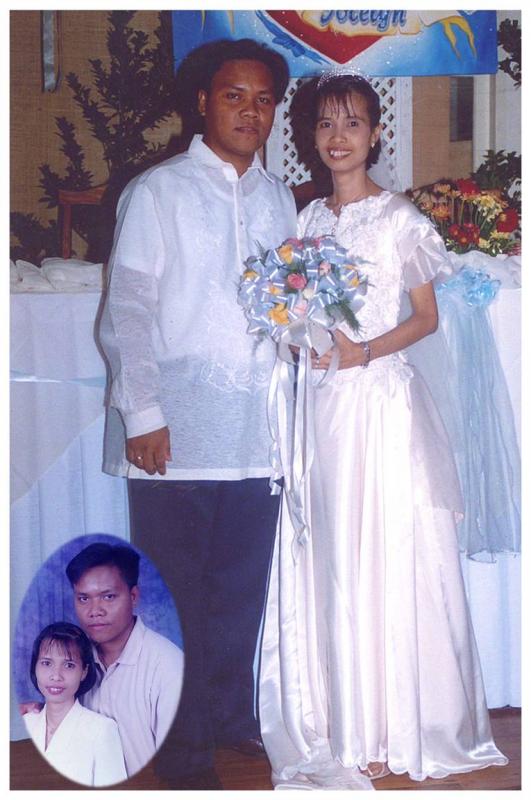
In August 2006, I was asked to come home to Cagayan de Oro for an emergency. From the port, my brother brought me straight to the Provincial Hospital. Our family hadn’t had the slightest clue that Ate was a couple of months pregnant.
That night, Ate Bem and her baby boy did not make it. I would like to believe that that was her last fight for normalcy.
Ate Bem's life was a life of courage and love. Her illness made our family stronger and more loving. In her weakness, we saw strength. She is dearly missed.
Peace By Peace

|
St Teresa of Avila (28 March 1515 – 4/15 October 1582) Let nothing disturb you, Nada te turbe, ~ Sta Teresa de Avila, Mystic, Doctor of the Church (1515 – 1582) ~ |
 Trivia about St Teresa. She died during the night of Thursday 4 October 1582 which was followed by Friday 15 October 1582 when the Julian Calendar was replaced by the calendar now followed universally and known as the Gregorian Calendar, after Pope Gregory XIII who had decreed the change. The saints’ feast day is 15 October. |
|
|
|
 Edison as a boy |
Non-violence leads to the highest ethics, which is the goal of all evolution. Until we stop harming all other living beings, we are still savages.
~ Thomas Alva Edison, American Inventor and Businessman (1847 – 1931) ~
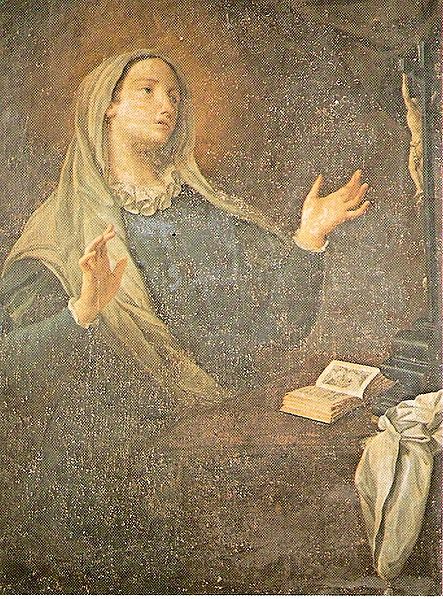
St Catherine of Genoa (painted by Giovanni Agostino Ratti)
When the soul is naughted and transformed, then of herself she neither works nor speaks nor wills, nor feels nor hears nor understands; neither has she of herself the feeling of outward or inward, where she may move. And in all things it is God who rules and guides her, without the meditation of any creature.... And she is so full of peace that thought she pressed her flesh, her nerves, her bones, no other thing come forth from them than peace.
~ St Catherine of Genoa, Mystic (1447 – 1510) ~

Clement Shahbaz Bhatti (9 September 1968 - 2 March 2011)
Federal Minister for Minority Affairs, Pakistan (2 November 2008 - 2 March 2011)
‘I have been asked to put an end to my battle, but I have always refused, even at the risk of my own life. My response has always been the same. I do not want popularity, I do not want positions of power. I only want a place at the feet of Jesus. I want my life, my character, my actions to speak of me and say that I am following Jesus Christ. This desire is so strong in me that I consider myself privileged whenever – in my combative effort to help the needy, the poor, the persecuted Christians of Pakistan – Jesus should wish to accept the sacrifice of my life. I want to live for Christ and it is for Him that I want to die. I do not feel any fear in this country . . .
‘I say that, as long as I am alive, until the last breath, I will continue to serve Jesus and this poor, suffering humanity, the Christians, the needy, the poor . . .
‘I believe that the needy, the poor, the orphans, whatever their religion, must be considered above all as human beings. I think that these persons are part of my body in Christ, that they are the persecuted and needy part of the body of Christ. If we bring this mission to its conclusion, then we will have won a place at the feet of Jesus, and I will be able to look at him without feeling shame.’
(Quotations from an article by Luciano Larivera SJ and used by Sandro Magister on his website.)
His Blood Cries Out
Verse 1.
These are the hands
They praise the life of you
These are the veins
Your life and love flow through
These are the words we try to write for you
We sing this song
Refrain/Chorus
His Blood Cries Out
His Blood Cries Out
Verse 2.
Peace is the star
That guides our hearts to you
Hear all the angels
How they sing for you
These are the words we try to write for you
Help us to erase
This war, this rage
We need to turn the page and
Find true peace within love's heart
In the silence hear the shout
His blood cries out
Refrain/Chorus
His blood cries out
His blood cries out
Verse 3.
These are the prayers
Helpless and the weak
His was the voice
For those that couldn't speak
For this we cry
Freedom, Love and Peace
What have you done
This war, this rage,
We need to turn the page and
Find true peace within love's heart
In the silence hear the shout
His blood cries out
Refrain/Chorus.
His blood cries out
His blood cries out.........
Abortion Destroys Life
I think that abortion is the greatest destroyer of peace today precisely because it is war. It is killing. It is a deliberate and calculated murder carried out with the mother’s collaboration. We read in Scripture what God clearly says about this: ‘Even if a mother should forget her child, I shall not forsake you. You are in the palm of my hand’. God has us in the very palm of his hand. And that is what strikes me. Even if a mother could forget her child which seems impossible, ‘I will not forsake you’. Today abortion is the greatest and most effective destroyer of peace.
~ One Heart Full of Love, Mother Teresa of Calcutta, Founder of the Missionaries of Charity (1910 – 1997) ~
The Beatitudes
Blessed are the poor in spirit, for theirs is the kingdom of heaven.
Blessed are those who mourn, for they will be comforted.
Blessed are the meek, for they will inherit the earth.
Blessed are those who hunger and thirst for righteousness, for they will be filled.
Blessed are the merciful, for they will be shown mercy.
Blessed are the pure in heart, for they will see God.
Blessed are the peacemakers, for they will be called children of God.
Blessed are those who are persecuted because of righteousness, for theirs is the kingdom of heaven.
Blessed are you when people insult you, persecute you and falsely say all kinds of evil against you because of me. Rejoice and be glad, because great is your reward in heaven, for in the same way they persecuted the prophets who were before you.
~ Matthew 5:3-12 (New American Bible) ~
The Sermon on the Mount from The Gospel According to St Matthew by Pier Paolo Pasolini (1964)

The Ordination of St Hilary of Poitiers (from a 14th century manuscript)
Her womb made flower a Fruit, a Bread that has filled us with an angelic gift. Mary restored to salvation what Eve had destroyed by her sin.
~ Saint Hilary of Poitiers, Bishop of Poitiers, Doctor of the Church (c. 300 – c. 368) ~

Cathedral of St Peter of Poitiers
The Palm Branch and the Lily
By Hannah Carter
A young Filipino martyred in Guam in 1672 when he was maybe 17, Blessed Pedro Calungsod, who is shown in portraits holding the palm of martyrs, and a young woman of Mohawk-Algonquin parentage born in 1656 in what is now New York State, Blessed Kateri Tekakwitha, known as the Lily of the Mohawks, who died in 1680 in what was then New France, now part of Canada, will be canonized together by Pope Benedict XVI on 21 October. The author, an American with close family ties to the Philippines, sees the connections between their lives and with that of her teenage son.
We have great cause for joy in the canonization of the teenage martyr Blessed Pedro Calungsod on 21 October. His devotion, courage and zeal to share his faith as a catechist are a shining and attractive example for all of us. St Pedro’s youth makes his story all the more poignant. Our teens are blessed to have such a model as they strive to live the Catholic Faith in a secular world, often hostile to the message of the gospel. I am the mother of an older adolescent and I have witnessed my son’s struggles, surrounded by these negative influences. It is hard to be a young person in today’s world, although the grace of Our Lord always suffices.
Young Pedro Calungsod studied with the Jesuits in the mid 1600s, during years when the Society of Jesus was expanding its missionary activity throughout the world ‘to the greater glory of God’. It was just over 100 years since the foundation of the Society, and its singular purpose drove many of the members to heroic virtue and even martyrdom. The lay persons associated with their mission often shared the same life and death in far-flung outposts. So it was that Pedro Calungsod accepted the invitation to accompany the Superior of the Jesuit mission to Guam and the other Mariana Islands, Blessed Diego Luis de San Vitores. Pedro may have been only 12-15 years old when he left his native Visayas to travel as a missionary to the Chamorro people. As a mother, I wonder about things like his parents' reaction to this dramatic departure. I wonder if Pedro shed tears of homesickness into his pillow during the voyage.

This week I knelt on holy ground. I visited the National Shrine of the North American Martyrs in Auriesville, New York, where three French Jesuit missionaries were martyred between 1642 and 1646. This sacred place is called America's reliquary because the remains of one martyr were buried in the now silent ravine, and the other two battered and precious bodies thrown into the nearby Hudson River. Auriesville is surely one of the ‘thin places’, as some describe points of contact between heaven and earth. The parallels between the sacrifice of St Pedro, that of Blessed Diego and these martyrs are powerful. They lived in the same time period, though on opposite sides of the world. Both groups served selflessly in the Company of Jesus.
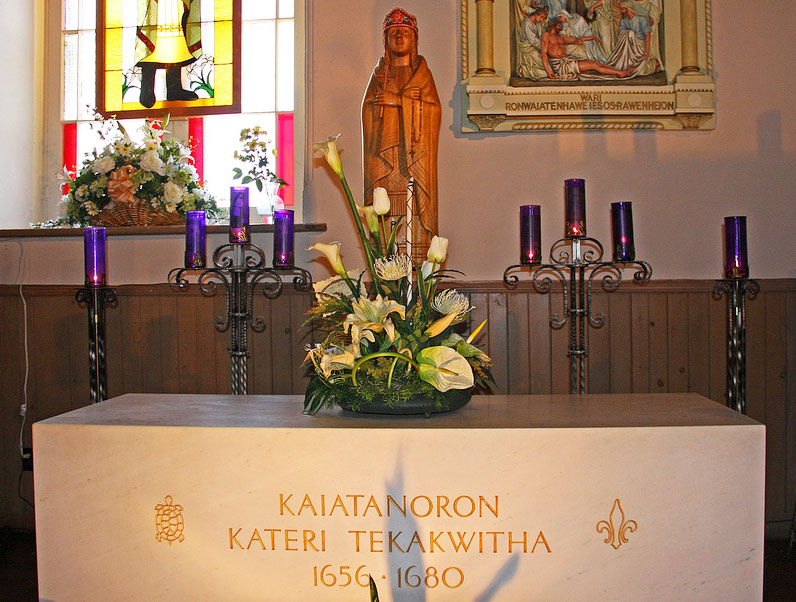
We have repeatedly heard the words of Tertullian (c.160 – c.225), ‘The blood of martyrs is the seed of the Church’. After the martyrdom of St Pedro and his superior, Blessed Diego, the Chamorro people of Guam and the Marianas became firmly Catholic and have remained so to this day. At Auriesville, St Kateri Tekakwitha, a Native American of the Mohawk tribe, was born ten years after the martyrs' deaths in her own community and just a year after St Pedro Calungsod’s birth. Kateri reached an amazing height of sanctity in a very short period, baptized at 20 and dying at 24. She will be canonized at the same ceremony as Pedro Calungsod this October.
It is a deep joy for me to celebrate these two heavenly friends raised to the honors of the altar on the same day. I have prayed at the spot of St Pedro’s martyrdom in Tumon, Guam, and been immersed in the warm crystal-blue waters of Tumon Bay where his sacred relics were cast after his martyrdom. I have prayed many times, most recently last week, at the tomb of St Kateri in Canada. Her beautifully simple marble sarcophagus reads ‘Precious Kateri Tekakwitha’ in Mohawk. Pedro and Kateri, canonized together . . . the palm branch and the lily. Beyond coincidence, this gift of God is ‘hulog sang langit’.
I reflected at greater length on these connections and their meaning. These two children of divine predilection were born within a year of each other in the long-ago 17th century. Both would grow to be courageous and holy young people, answering a wholehearted ‘yes’ to the call of God. They would be linked to and deeply influenced by the missionary outreach of the Society of Jesus. Finally, after lives of heroic virtue, they will share the honors of the altar on 21 October. St Pedro and St Kateri are tied to specific and dramatic historical moments which remove them from our daily experience, but their Christian witness endures for our inspiration and imitation.
St Pedro died at the side of Blessed Diego whom he refused to leave when they were attacked for baptizing the daughter of a hostile chief. St Pedro’s devotion in offering his ultimate gift in reverence for the priesthood and witnessing to the sacrament of baptism makes us examine our lives: do we pray for the priests who serve us in the name of Jesus? Is baptism a profoundly transforming event in our lives? Do we realize the sacred duty of godparents beyond the purely social aspects? St Pedro and St Kateri lived through daily privation without complaint. They suffered extreme heat and cold, respectively, along with myriad other discomforts. Surely we can endure our small inconveniences more cheerfully in their honor.
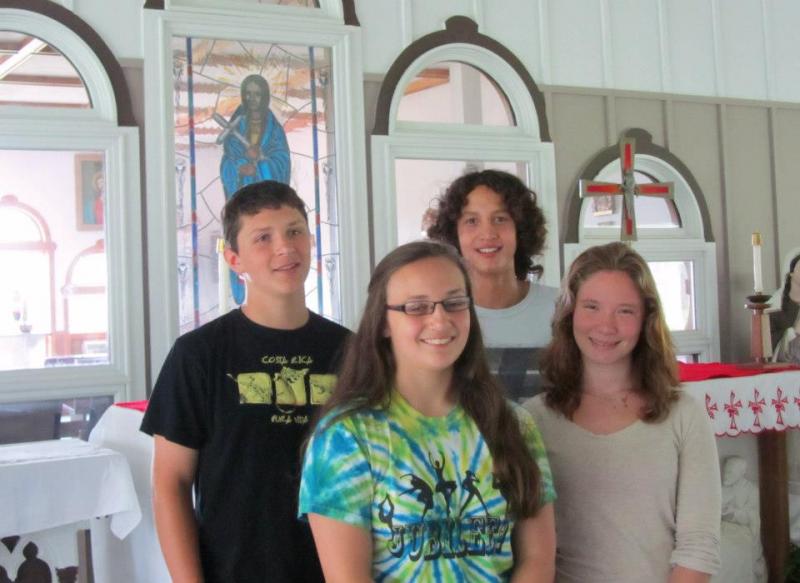
Joseph, 2nd from right, with his cousins David and Bethany and their friend Amy
I brought my 16-year-old son Joseph to Auriesville this past week. His dad (Visayan like St Pedro) hails from Ilog, near Kabankalan City, Negros Occidental. Joseph’s middle name is Lorenzo, and he has heard about his patron St Lorenzo Ruiz since early childhood. Now he is learning about the second Filipino saint, Pedro Calungsod. At Auriesville I was able to introduce Joseph to the North American Jesuit martyrs and to Kateri. Joseph is proud of both his Filipino and French-Canadian heritage and as an older teen can appreciate the witness of these saints so close to his own age. At Auriesville I watched him walk the grounds with his teenage cousins. The young people were subdued and reverent, considering the courageous sacrifices poured out on the very soil beneath their feet. The example of St Pedro Calungsod will be equally moving and empowering for our youth once his story is more widely known.
A favorite hymn of the Filipino choir that sings at my parish is the Prayer of St Ignatius, founder of the Society of Jesus, ‘Take and Receive’. Our young saints exemplified the spirit of this prayer so earnestly that we do well to think on the lyrics and echo them in our hearts. Let us pray these words with gratitude for the gift of our new saints:
‘Take and receive, O Lord, my liberty
Take all my will, my mind, my memory
All things I hold and all I own are Thine
Thine was the gift, to Thee I all resign.
Do Thou direct and govern all and sway
Do what Thou wilt, command, and I obey
Only Thy grace, Thy love on me bestow
These make me rich, all else will I forego.’
(Translation and music by Fr Manuel Francisco SJ).
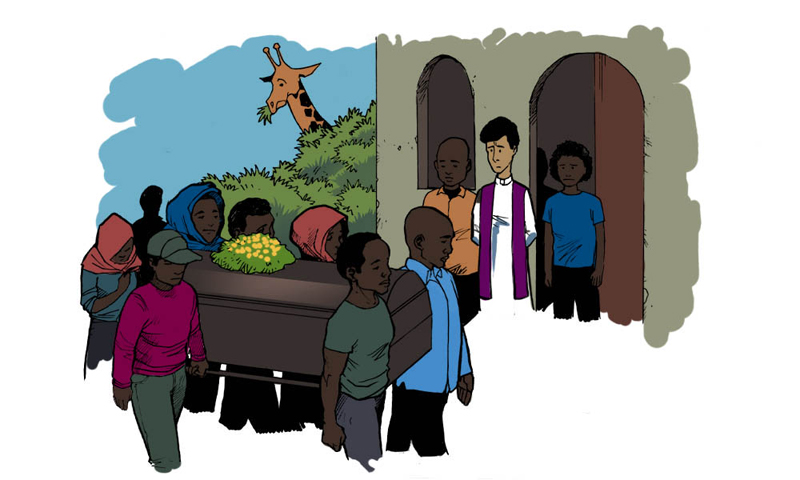 The marriage ceremony was set for 10:00 AM. By 12:30 PM a procession was in sight. ‘Here they are; prepare!’ I alerted the altar boys but the excitement died abruptly when, to our surprise, behind the choir we saw a coffin. It was a group of Methodists on their way to the cemetery to bury one of their members. Sympathy and laughter were quite hard to combine. Finally at 3:30 PM the bride and the groom came. And that was my first and last time to officiate at a wedding ceremony in Asesewa, Ghana. Not until did I know I could be that patient.
The marriage ceremony was set for 10:00 AM. By 12:30 PM a procession was in sight. ‘Here they are; prepare!’ I alerted the altar boys but the excitement died abruptly when, to our surprise, behind the choir we saw a coffin. It was a group of Methodists on their way to the cemetery to bury one of their members. Sympathy and laughter were quite hard to combine. Finally at 3:30 PM the bride and the groom came. And that was my first and last time to officiate at a wedding ceremony in Asesewa, Ghana. Not until did I know I could be that patient.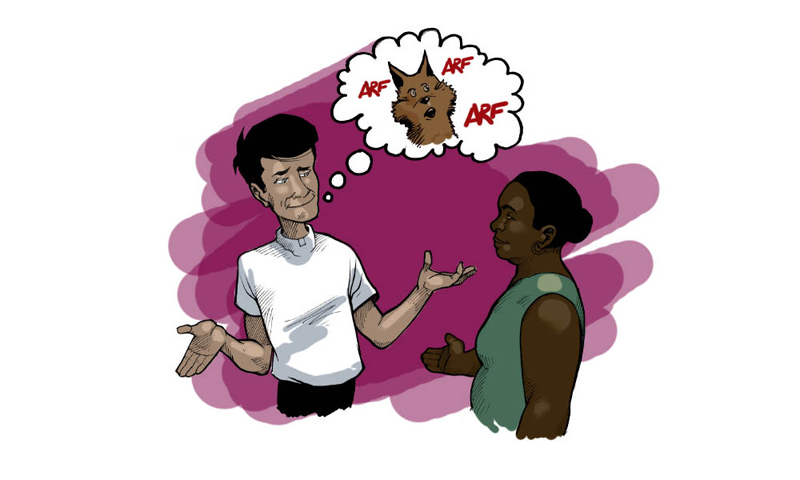 Brutus and Castro are our two German Shepherd dogs in Asesewa, though not purebred. One night I heard Brutus barking wildly, kicking its house and feeding trough with such noise that he was obviously misbehaving. The following morning, I asked Georgina, our cook, what had happened last night and giggling she answered, ‘I gave him only a little food’. Then I remembered that the dog food had run out a few days earlier and the next consignment was still to come.
Brutus and Castro are our two German Shepherd dogs in Asesewa, though not purebred. One night I heard Brutus barking wildly, kicking its house and feeding trough with such noise that he was obviously misbehaving. The following morning, I asked Georgina, our cook, what had happened last night and giggling she answered, ‘I gave him only a little food’. Then I remembered that the dog food had run out a few days earlier and the next consignment was still to come.